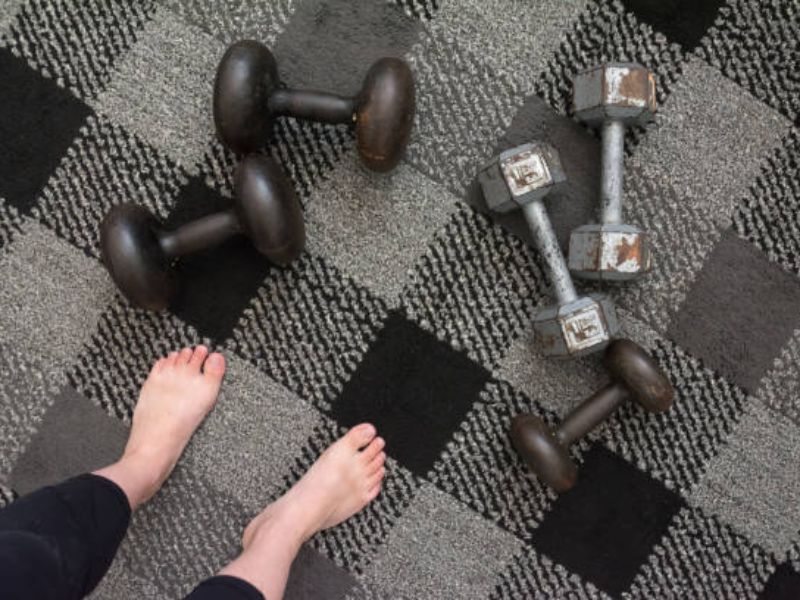Strength training to failure is the secret sauce of weight loss and body transformation.
Picture it as the last lap of a race, where you push yourself to give it your all until you cross that finish line.
In fitness terms, it means taking your muscles to their absolute limit, squeezing out every last ounce of effort until they can’t perform another rep with proper form.
But here’s the magic: not only does this method build strength, but it also ignites a calorie-burning inferno that continues long after your workout ends.
If you’re ready to shed pounds, sculpt a leaner physique, and unleash your full potential, then strength training to failure is your ultimate ticket to success.
Understanding Strength Training to Failure

Defining “Training to Failure” in Strength Workouts
Training to failure is like the last lap of a race, where you push yourself to give it your all until you cross that finish line.
In the world of strength training, it’s about taking your muscles to their absolute limit, squeezing out every last drop of effort until they simply can’t perform another rep with proper form.
Picture this: you’re hitting the gym, grabbing those dumbbells, and gearing up for a set of bicep curls. As you curl those weights up, you can feel the burn starting to kick in.
But instead of stopping when it gets tough, you push through, grinding out rep after rep until your muscles scream for mercy.
That, my friends, is training to failure in action.
But let’s clear up any misconceptions right off the bat. Training to failure doesn’t mean pushing yourself to the point of collapse or risking injury in the name of gains.
It’s about pushing yourself just beyond your comfort zone, challenging your muscles to adapt and grow stronger in response.
Exploring the Concept of Pushing Muscles to Their Limits

When we talk about pushing muscles to their limits, we’re not talking about mindlessly throwing weights around until you collapse in a heap on the floor (ouch.).
Instead, it’s about challenging yourself to the point where you’re working at maximum effort, but still maintaining control and proper form.
Think of it like this: your muscles are like rubber bands. When you stretch them too far, they snap. But when you stretch them just enough, they become stronger and more resilient.
That’s what training to failure does for your muscles.
By pushing your muscles to their limits, you’re sending a powerful signal to your body that says, “Hey, we need to get stronger to handle this kind of stress in the future.”
And in response, your muscles adapt and grow stronger, helping you become fitter, leaner, and more badass than ever before.
Taking it to Failure Safely:
Now, if you want to push your limits and go for failure, it’s advisable to prioritize safety. Here are a couple of options:
- Drop Sets: Once you reach failure on a set with a specific weight, you can immediately reduce the weight slightly and continue performing reps. This allows you to keep challenging your muscles with good form even after reaching your limit with the heavier weight.
- Lighter Weights, More Reps: Another approach is to use a lighter weight that allows you to perform more repetitions after reaching failure with a heavier weight. This maintains tension on the muscle and promotes growth while minimizing injury risk.
So, next time you hit the gym, don’t be afraid to push yourself. Embrace the challenge, give it your all, and watch as your muscles rise to the occasion.
Benefits of Training to Failure for Weight Loss

Strength Training to failure isn’t just about pushing yourself to the brink—it’s about unlocking a whole world of benefits that can supercharge your weight loss journey:
- Increased Calorie Burn: Pushing your muscles to their limits ignites a metabolic inferno, torching calories during and after your workout thanks to EPOC.
- Enhanced Muscle Growth: By pushing muscles past their breaking point, you stimulate growth and definition, sculpting a stronger, leaner physique.
- Boosted Metabolism: Building muscle through training to failure turbocharges your metabolism, making it more efficient at burning fat in the long run.
- Improved Strength and Performance: Training to failure not only builds strength but also boosts confidence and performance in the gym and everyday life.
So, whether you’re aiming to shed pounds or sculpt a stronger physique, strength training to failure is your ticket to reaching your fitness goals faster and with more confidence.
Is training to failure safe for beginners?

First things first: is strength training to failure for weight loss safe? Absolutely, but like any form of exercise, it’s essential to approach it with caution and respect for your body’s limits.
While pushing your muscles to their limits is part of the process, it’s crucial to prioritize safety and avoid overexertion.
Proper form is your best defense against injury, especially when engaging in strength training to failure.
Before diving into your workout, take the time to learn and practice the correct form for each exercise.
Focus on smooth, controlled movements, and avoid using momentum to power through reps.
As we discussed earlier, do drop set if you’re using heavy weight. Because engaging the right muscles and maintaining good alignment not only maximizes results but also reduces the risk of strain or injury.
Gradual Progression and Tuning into the Body’s Signals

One of the most common mistakes beginners make when starting with strength training to failure is biting off more than they can chew.
Remember, building strength and endurance is a journey, not a sprint.
Take a gradual approach to intensity, gradually increasing weight and difficulty over time as your strength and confidence grow.
And always listen to your body’s signals—if something feels off or overly strained, don’t hesitate to scale back and reassess.
Consistency and patience are key to long-term success in strength training to failure for weight loss, so trust the process and enjoy the journey to a stronger, fitter you.
Tips for Safe and Effective Training to Failure
Preparing Muscles with Effective Warm-up Routines

Before diving into your strength training to failure session, it’s crucial to prime your muscles for action with a proper warm-up.
Start with dynamic stretches and movements that target the muscles you’ll be working, such as arm circles, leg swings, and torso twists.
Utilizing Drop Sets for Enhanced Muscle Engagement

As we have already discussed above about the drop set benefits, incorporating drop sets into your strength training to failure routine can take your workouts to the next level.
By reducing the weight after reaching failure on a set, you can squeeze out additional reps and stimulate further muscle growth.
It’s like giving your muscles an extra push when they need it most, helping you maximize your gains and push past plateaus.
Prioritizing Controlled Movements over Jerky Motions

When training to failure, it’s essential to maintain proper form and technique throughout each exercise. Focus on smooth, controlled movements, and avoid using momentum to power through reps.
Jerky motions not only increase your risk of injury but also diminish the effectiveness of your workout, as your muscles aren’t fully engaged.
Balancing Intensity with Adequate Rest and Recovery

As tempting as it may be to push yourself to the limit every day, rest and recovery are just as crucial as the workout itself.
Strength training to failure places a significant amount of stress on your muscles, and they need time to repair and rebuild stronger than before.
Incorporate rest days into your routine to allow your body to recover fully, and don’t hesitate to scale back intensity or volume if you’re feeling overly fatigued.
Integrating Training to Failure into Your Workout Routine
Determining the Frequency of Training to Failure Sessions

When it comes to incorporating strength training to failure for weight loss into your workout routine, balance is key.
There are no definite numbers, it depends on your fitness level, goals, and recovery capacity.
Overdoing it can lead to burnout and increased risk of injury, so listen to your body and adjust frequency accordingly.
I would suggest going failure to each exercise last set. As, it would look like a finisher set.
Strategising When to Implement Training to Failure on Each Set
While strength training to failure can be an effective way to stimulate muscle growth, it’s not necessary (or advisable) to push yourself to the limit on every set.
Instead, focus on quality over quantity, and save training to failure for your last set or two of each exercise.
This approach allows you to maximise muscle recruitment and fatigue without overtaxing your body.
Conclusion
In conclusion, strength training to failure offers a powerful approach to weight loss and body transformation. By pushing your muscles to their limits and igniting a calorie-burning inferno, you can achieve results that go beyond what traditional cardio workouts alone can provide.
Understanding the concept of strength training to failure for weight loss, its benefits, and its safe integration into your workout routine is essential for maximizing its effectiveness and minimizing the risk of injury.
Training to failure isn’t about reckless exertion; it’s about challenging yourself smartly and effectively. With proper form, gradual progression, and attentive listening to your body’s signals, you can harness the full potential of strength training to failure for weight loss while minimizing the risk of overexertion or injury.
Incorporating tips like warm-up exercises, drop sets, controlled movements, and adequate rest and recovery will help you optimize your strength training to failure routine for maximum results.
Remember, it’s not about pushing yourself to the brink on every set but rather about strategic application and balancing intensity with recovery.
So, if you’re ready to embark on a journey to a stronger, leaner, and more resilient you, then strength training to failure is your ultimate ticket to success.
Embrace the challenge, listen to your body, and unleash your full potential. Your fitness goals are within reach—let’s make it happen.

